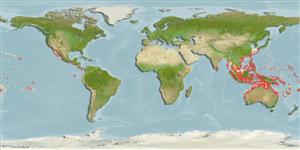Environment: milieu / climate zone / depth range / distribution range
Écologie
marin récifal; non migrateur; profondeur 4 - 55 m (Ref. 30874). Tropical; 32°N - 32°S
Western Pacific: Christmas Island in the eastern Indian Ocean to Fiji, north to southern Japan, south to Scott Reef (eastern Indian Ocean) and Lord Howe Island. Uncommon around oceanic islands (Ref. 9710).
Taille / Poids / Âge
Maturity: Lm ? range ? - ? cm
Max length : 19.0 cm TL mâle / non sexé; (Ref. 9710); âge max. reporté: 6 années (Ref. 11318)
Épines dorsales (Total) : 14; Rayons mous dorsaux (Total) : 15 - 16; Épines anales: 3; Rayons mous anaux: 16 - 17. Overall black with an elongate vertical black blotch on the middle of the upper sides. When small, mainly black with a white bar; the white bar changes to a central blotch and varies greatly in shape and size (Ref. 48636). Dorsal and anal fins with submarginal blue line; most of the pelvic and the anterior portion of the anal fin yellow. Caudal fin with submarginal blue line (Ref. 1602). Body depth 1.8-2.0 in SL. Scales longitudinal series 45-48 (Ref. 90102).
Relatively uncommon in mixed coral and rubble areas of lagoon and seaward reefs. The largest member of the genus (Ref. 1602). Feeds mainly on algae. Forms harems of 3-7 individuals. Frequently exported through the aquarium trade (Ref. 48391).
Life cycle and mating behavior
Maturities | Reproduction | Spawnings | Egg(s) | Fecundities | Larves
Sex reversal is completed in 29-35 days (Ref. 34253).
Myers, R.F., 1991. Micronesian reef fishes. Second Ed. Coral Graphics, Barrigada, Guam. 298 p. (Ref. 1602)
Statut dans la liste rouge de l'IUCN (Ref. 130435)
Menace pour l'homme
Harmless
Utilisations par l'homme
Pêcheries: commercial; Aquarium: Commercial
Outils
Articles particuliers
Télécharger en XML
Sources Internet
Estimates based on models
Preferred temperature (Ref.
123201): 24.5 - 29, mean 28.1 °C (based on 884 cells).
Phylogenetic diversity index (Ref.
82804): PD
50 = 0.5000 [Uniqueness, from 0.5 = low to 2.0 = high].
Bayesian length-weight: a=0.03631 (0.02001 - 0.06587), b=2.85 (2.70 - 3.00), in cm total length, based on LWR estimates for this species & (Sub)family-body (Ref.
93245).
Niveau trophique (Ref.
69278): 2.8 ±0.35 se; based on food items.
Résilience (Ref.
120179): Milieu, temps minimum de doublement de population : 1,4 à 4,4 années (Preliminary K or Fecundity.).
Fishing Vulnerability (Ref.
59153): Low vulnerability (10 of 100).
Nutrients (Ref.
124155): Calcium = 67.1 [34.1, 106.2] mg/100g; Iron = 0.602 [0.372, 0.980] mg/100g; Protein = 18.2 [17.0, 19.3] %; Omega3 = 0.109 [0.069, 0.172] g/100g; Selenium = 28.9 [16.3, 52.2] μg/100g; VitaminA = 83.2 [22.8, 285.7] μg/100g; Zinc = 1.48 [1.03, 2.10] mg/100g (wet weight);
